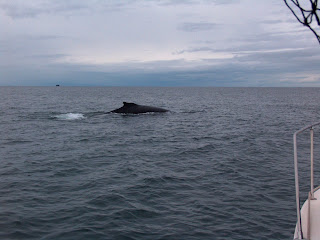
One of our main interests in the Homer area is getting out on the ocean in our sea kayaks. We have had a lot experience in the past on Alaska's rivers- our favorite being the Noatak which flows along the southern edge of the Brooks Range for nearly 500 miles before entering the sea near Kotzebue.
In 2003 we took an eight week float trip on the Noatak. It is very isolated with only one village along its whole length. We saw alot of wild animals but no other people for the first 26 days. So we have our wilderness camping technique down pat and are pretty good at dealing with wildlife. But this ocean business is a whole different deal.
For one thing the rivers we've floated don't change their depth every six hours. We had a 3 foot rise in the Noatak water level one night after a rain storm but that is nothing compared to the 20 to 30 foot tidal variation here on Kachemak Bay. You gotta be pretty darn careful where you park your boat around here!

Another difference is the fishing. On Interior rivers I could pretty easily catch our dinner every night- be it arctic char, grayling or that old standby northern pike. But out on the Bay you drop a line deep in the water and you never know what might grab it.

On our first overnight trip at Halibut Cove we went out in the double Klepper kayak to fish and soon caught two small halibut which my wife could pull right up into her lap. But the next bite I got felt a lot bigger. Naturally, I thought it was just a larger halibut but after five minutes of carefully reeling it in we were startled to see a creature right out of "Jaws" circling under our rubber boat! Okay, it was really only a four foot salmon shark but fish can look really big in the water. We coaxed the beautiful fish in to shore and Linda pulled it carefully onto the beach by its tail. She removed the hook with my needlenose pliers and within a minute the blue green fish was back in the lagoon.
We spent four days on Halibut Cove Lagoon that trip and each day crossed from our rented cabin to the wide beach on the other side to look for clams. We could get very close to comical otters and also saw several bay porpoise feeding in the lagoon. One day after clamming we headed back across what had been a calm and seemingly well protected one mile stretch of water. Halfway across what locals call the "day breeze" suddenly piped up from the west and we found ourselves paddling hard against a 20 knot wind with no spray skirt on our open boat to shed the spray from increasingly large whitecaps. We made it safely back to the cabin but still learned a very good lesson. We resolved to get closed cockpit sea kayaks and drysuits to protect ourselves before again venturing onto Kachemak Bay.
It has taken a few years but now we each have 17 foot long sea kayaks that are stable and safe in open ocean conditions. With the excellent training provided by Tom Pogson and his Alaska Kayak School we feel like we are ready to venture across the bay for extended trips....










